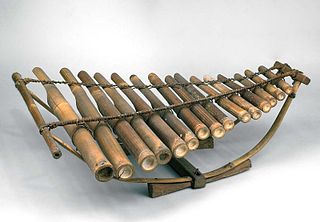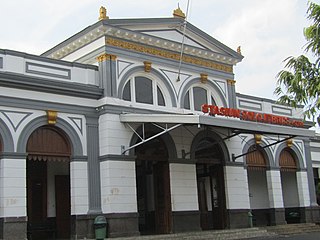
The Istana Budaya or also known as the Palace of Culture, is Malaysia's main venue for all types of theatre including musical theatre, operetta, classical concerts and opera from local and international performances. It is located in the heart of Kuala Lumpur city, next to the National Art Gallery.

Taman Mini Indonesia Indah is a culture-based recreational area located in East Jakarta, Indonesia. Since July 2021, it is operated by PT Taman Wisata Candi Borobudur, Prambanan, dan Ratu Boko, a subsidiary of the state-owned tourism holding company Injourney. It was operated by Yayasan Harapan Kita, a foundation established by Siti Hartinah, the first lady during most of the New Order and wife of Suharto, and run by Suharto's descendants since his death until 2021. It has an area of about 147 hectares. The project cost some US$ 26 million.

Garuda Wisnu Kencana Cultural Park, or GWK, is a tourist destination and attraction located at Ungasan, Badung on the island of Bali, Indonesia, about 10–15 minutes drive from Ngurah Rai International Airport. It is devoted to the Hindu god Vishnu, and his mount, Garuda, the mythical bird who became his companion.

Wayang wong, also known as wayang orang, is a type of classical Javanese and Balinese dance theatrical performance with themes taken from episodes of the Ramayāna or Mahabharāta. Performances are stylised, reflecting Javanese court culture:
Wayang wong dance drama in the central Javanese Kraton of Yogyakarta represents the epitome of Javanese aesthetic unity. It is total theatre involving dance, drama, music, visual arts, language, and literature. A highly cultured sense of formality permeates every aspect of its presentation.

The Calung is a type of Indonesian bamboo xylophone originating from Baduy culture and commonly used in Baduy, Bantenese, Sundanese, Banyumasan, and Balinese performances. The calung (instrument) consists of multiple bamboo tubes which are struck at the base to produce a woody sound.
Ivan Sagita was born in Malang 1957 and studied at the Indonesian Art Institute in Yogyakarta from 1979 to 1985. He is known as an introvert and mysterious artist, but his work of art is well known in the world of art.

Taman Sari Water Castle, also known as Taman Sari, is the site of a former royal garden of the Sultanate of Yogyakarta. It is located about 2 km south within the grounds of the Kraton, Yogyakarta, Indonesia. Built in the mid-18th century, the Taman Sari had multiple functions, such as a resting area, a workshop, a meditation area, a defense area, and a hiding place.

Afrizal Malna, is an Indonesian activist, writer of prose, poetry, and theatrical texts.

Ismail Marzuki Park,, is an arts, cultural, and science center located at Cikini in Jakarta, Indonesia. Taman Ismail Marzuki complex comprises a number of facilities including six performing arts theaters, cinemas, exhibition hall, gallery, libraries and an archive building. The complex is built on an 9 hectares land area, which was previously a zoo. TIM is named after Ismail Marzuki, one of Indonesia's most influential composers.

Cultural properties of Indonesia are those items defined by Indonesian law as of "important value for history, science, and culture", and include both man-made artefacts and natural objects. The cultural properties number more than 8,000 and include ancient Hindu and Buddhist temples, mosques, historic colonial buildings, forts, art galleries, national parks and beaches. A number of the sites are World Heritage Sites.

Bentara Budaya Yogyakarta is a cultural center located in Yogyakarta, Indonesia. Bentara Budaya Yogyakarta was opened on 26 September 1982, funded by Kompas Gramedia Group.

ARTJOG is a contemporary art fair, held annually in Taman Budaya Yogyakarta, Indonesia. The fair started out in 2008 as part of the Yogyakarta Art Festival. The Jogja Art Fair became independent in 2009, and changed its name to Art Jog in 2010. In 2019 ARTJOG rebranded as an art festival from an art fair.

Siti Zainon Ismail is a Malaysian novelist, short story writer, poet, and academic. She is best known for her multi-genre novel, Pulau Renik Ungu.

Bentara Budaya Jakarta is a cultural center located on Jalan Palmerah Selatan 17, Central Jakarta, Indonesia. The institution consists of a museum and an art gallery. Open from Monday to Friday at 8 AM to 5 PM, the gallery is closed on weekends and holidays, with an exception being made when special exhibitions are present. Entry to the gallery is free of charge and open to visitors.

The Indonesian New Art Movement, also known as Gerakan Seni Rupa Baru(GSRB) was an art movement of young artists from Bandung and Yogyakarta against the institutional concept of Indonesian fine art (Indonesian: Seni Rupa) being limited to paintings and sculptures. The movement emerged in 1974, first organised in a protest against the judging of the Second Jakarta Painting Biennale which awarded prizes to decorative style of paintings and sculptures. The protesters published the Black December Statement (Desember Hitam) criticising the lack of social and political consciousness in Indonesian decorative art practices.

Bandung Institute of Indonesian Arts and Culture, is a state-owned, arts and cultural-oriented educational institution located in Bandung, Indonesia.

Solo Jebres Station, also known as Jebres Station, is a type-C large class railway station in Surakarta, Central Java, Indonesia. The station, which is located 97 metres (318 ft) above sea level, is operated by Operational Area VI Yogyakarta of Kereta Api Indonesia (KAI). It is one of the major railway stations in the city.
















